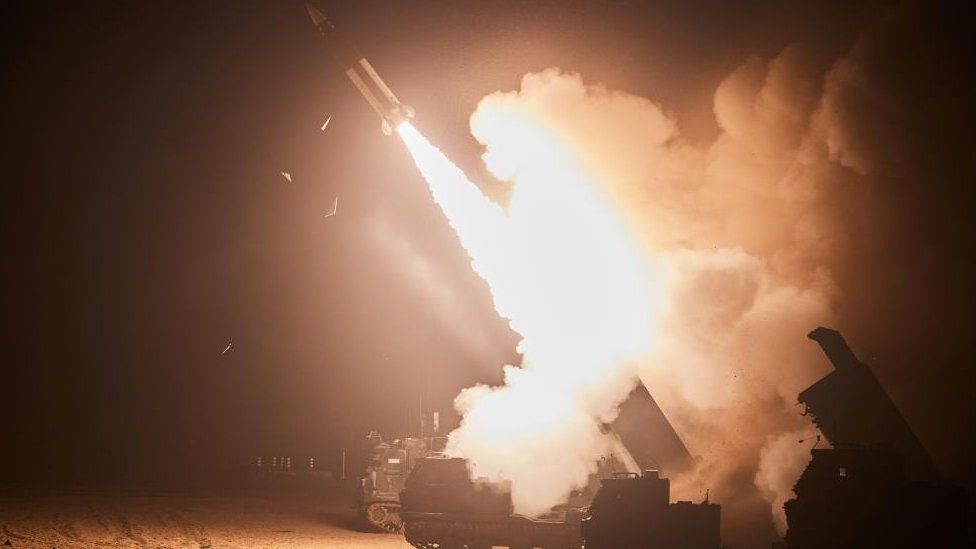Ukraine war: Kyiv uses longer-range US missiles for first time
- Published

Ukraine has begun using longer-range ballistic missiles against Russia that were secretly provided by the US, American officials have confirmed.
The weapons were sent as part of a previous US support package, and arrived this month. Officials said they were not announced publicly to maintain Ukraine's "operational security".
They have already been used at least once to strike Russian targets in occupied Crimea.
Further US aid is now heading to Kyiv.
More American weaponry is expected to be sent imminently, after President Joe Biden signed off on Wednesday a new package of economic and military support for Ukraine worth $61bn (£49bn).
The missiles that have already been quietly provided are the longer-range version of the Army Tactical Missile Systems (ATACMS), a state department spokesman confirmed on Wednesday.
The US previously supplied Ukraine with a mid-range version of the ATACMS, but had resisted sending anything more powerful, partly over concerns about compromising US military readiness.
Officials were also concerned that the Ukrainians could use the weaponry to strike inside Russian territory, causing the conflict to escalate, according to NBC, which first reported the news.
The Ukrainians have long called for the systems, which can fire missiles up to 300km (186 miles). Mr Biden is said to have secretly given the green light in February.
Briefing reporters on Wednesday, the state department spokesman confirmed that the provision of the longer-range ATACMS had been "at the president's direct direction".
The US "did not announce this at the onset in order to maintain operational security for Ukraine at their request", Vedant Patel explained.
It is not clear how many of the weapons have already been sent, but US National Security Advisor Jake Sullivan said Washington planned to send more.
"They will make a difference. But as I've said before at this podium... there is no silver bullet," he said.
The longer-range ATACMS give Ukraine the ability to strike deeper into Russian-held areas; particularly bases, storage facilities and logistics hubs.
They were used for the first time last week to strike a Russian airfield in occupied Crimea, US media reported, and then in an attack on Russian troops in the occupied port city of Berdyansk overnight on Tuesday.
Russia said on Wednesday that the new weaponry "will not fundamentally change the outcome" of the war.
Recent months have seen Kyiv step up its calls for Western assistance as its stocks of ammunition are depleted and Russia makes steady gains.
The new aid package that was rubber-stamped by Mr Biden on Wednesday follows months of gridlock amid opposition to the aid from some in Congress.
A billion-dollar weapons package is expected to be the first of many from the $61bn of fresh aid, not all of which will be spent on arms.
US security assistance previously sent to Ukraine since the start of Russia's full-scale invasion totals $44bn.
"It's going to make America safer, it's going to make the world safer," the US president said after signing the new aid into law.
Reacting to the package, Ukrainian President Volodymyr Zelensky said: "Now we will do everything to make up for half a year spent in debates and doubts.
"What the Russian occupier was able to do during this time, what Putin is now planning, we must turn against him."
Mr Zelensky recently warned that a Russian offensive was expected in the coming weeks after Ukraine's loss of the city of Avdiivka during the winter.
Ukrainian forces have suffered from a shortage of ammunition and air defence systems in recent months and officials have blamed delays in military aid from the US and other Western allies for the loss of lives and territory.
Mr Sullivan said on Wednesday it was "certainly possible that Russia could make additional tactical gains in the coming weeks".
Since Russia invaded Ukraine on 24 February 2022, tens of thousands of people, most of them soldiers, have been killed or injured on both sides and millions of people have fled their homes.
Additional reporting by BBC weapons analyst Chris Partridge
Related Topics
- Published24 April
- Published23 April
- Published23 April